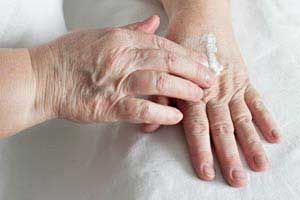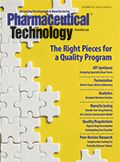QbD Takes Shape for Topical Pharmaceuticals
As they seek to increase the number of generics available, regulators are requiring that in-vitro and other test data be used for ANDAs, and promoting the concept of biowaivers that would allow such data to replace costly clinical studies.
HENADZY - STOCK.ADOBE.COM

Although therapeutic creams and ointments have been in use for centuries, development of topical pharmaceuticals is complex and costly. Many topical formulations involve multiple excipients and active ingredients. Their manufacturing is also expensive, requiring large-scale mixing and heating and precise volume filling and packaging, as Markham Luke, director of therapeutic performance of generic drugs at FDA, pointed out in 2017 (1).
But individual patient differences increase the challenges involved. On the most basic level, each topical formulation will penetrate the skin differently in individuals of different ages, sexes, and races, and occur at different rates in different parts of the same person’s body, says Vijendra Nalamothu, CEO and chairman of Tergus Pharma, a contract research and development company that specializes in topicals. “Skin absorption for a psoriasis treatment used on the hands will be very different from that for an alopecia therapy targeting the hair follicles on the scalp,” he says.
Given the variability, cost, and complexity of developing topicals, generic pharmaceuticals have not made significant inroads into the specialized and highly segmented market. At a time when generics account for more than 90% of the drugs prescribed in the United States, 80% of name-brand topical drugs on the market have fewer than three generic equivalents, according to Sam Raney, lead for topical and transdermal drug products at FDA’s Office of Generic Drugs. Most name-brand topicals do not even have one generic equivalent, Raney noted during an FDA workshop held on July 30, 2019 at the University of Maryland’s School of Pharmacy (2).
Also inhibiting topical generics development is bioequivalence testing, which demonstrates that both name brand and generic release active ingredient where it is needed within the body at the same concentration at the same time and under the same conditions. Bioequivalence for topicals has traditionally been determined in the clinic, using comparative endpoint studies, which can involve “enormous risk and investment,” and require thousands of patients, Raney said. Manufacturers and regulators are establishing a framework for more efficient science-based approaches, not only to testing for bioequivalence but for ensuring product quality. For regulators, the goal is to enable more generic manufacturers to enter the market.
TCS classification
To consider questions of bioequivalence in a more scientific way, regulators developed the Topical Classification System (TCS), a framework analogous to the Biological Classification System (BCS) for solid dosage forms, which classifies them based on solubility, permeability, and dissolution. Just as the BCS allows developers a biowaiver in some cases so they can bypass clinical bioequivalence testing, so does the TCS, Raney explained in a webcast for the Product Quality Research Institute (3).
The Q1 category represents an “outer bound,” for demonstrating qualitative similarity, in which reference and test product both contain the same components. The Q2 category goes a step farther: in order to be similar, the generic and reference drug would not only have the same components but they’d follow the same exact recipe and composition. Q3 similarity would mean that, in addition to having the same recipe and containing the same ingredients, the two would show a similar microstructure or arrangement of matter (i.e., physical and structural properties), he explained. This structure would make it “thermodynamically impossible” for them to behave differently, Raney said.
Q1 and Q2 similarity might mitigate product failure due to irritation or sensitization, where similar Q3 would reduce the risk of product failure due to differences in pH, polymorphism, rheology, entrapped air, drying rate, and other factors, Raney said, noting that excipients can have a major impact on structural properties ( i.e., Q3).
Under TCS, Class I topicals (for which Q1, Q2, and Q3 are the same for both the generic and the reference drug) and Class III topicals (for which Q1 and Q2 are different but Q3 is the same) would be eligible for biowaivers.
Within this framework, in-vitro testing methods (i.e., in-vitro release testing [IVRT], as standardized by the US Pharmacopeia’s (USP) <1724> using static Franz diffusion cells or in-line devices); physical tests for rheology and viscosity; and in-vitro permeation tests (IVPT), which examine pharmacokinetics of the product, are playing a much more important role in topical product development. As Raney emphasized, no single test can definitively show Q3 microstructural similarity. The tests provide insights into product performance and critical quality attributes such as release rate.
Through the Generic Drug User Fee Amendments Act (GDUFA), FDA has sponsored research to study in-vitro testing methods, which resulted in product-specific guidance documents for performing bioequivalence testing for topical generics. The most far-reaching was its draft guidance for determining the bioequivalence for acyclovir cream, published in 2016 (4), which spelled out clearly how in-vitro release and in-vitro permeation study data might be used to enable the issuance of a biowaiver. In this case, a developer could skip clinical bioequivalence testing if both test and reference drugs showed Q1, Q2, and Q3 similarity; they both showed an equivalent rate of API release based on IVRT testing; and they were shown to be bioequivalent based on acceptable IVPT results.
FDA is clearly stepping up its efforts to facilitate development of topical generics. To date, the agency has published seven product-specific guidance documents specifying how to establish bioequivalence. By September 2019, topicals accounted for 12 of the 45 product-specific guidance documents for complex generics that were issued by FDA’s Office of Generics, and minor revisions were planned for another 53 topical product-specific guidance documents, representing more than 60% of the total (5).
In addition, the principles of pharmaceutical quality by design (QbD) are becoming better established within the industry. Vijendra Nalamothu shared his views on how topical development is evolving with PharmTech.
PharmTech: When did you first start using quality-by-design (QbD) principles for topical development?
Nalamothu: As part of the SUPAC (short for Scale-Up and Post Approval Changes: CMC, IVRT and In-Vivo Bioequivalence) initiative (6), we were already using in-vitro release testing methods, so we began to use them to develop a design space for QbD. Back in 2012, we used in-vitro permeation testing (IVPT) plus tests for rheology and viscosity as a way to measure critical quality attributes (CQAs). We then took a deeper dive into determining CQAs using microstructure (or, according to the Topical Classification System, the Q3 characterization), applying specific rheological profiles, such as stress and shear curves and other methods. The industry started to use more of these tools to take a QbD approach to topicals. Now, FDA is requiring that generic pharmaceutical companies use IVPT, rheology, and polymorphic data.
PharmTech: Do you expect FDA to issue more generalized guidance on in-vitro testing for topicals in the future?
Nalamothu: FDA has issued seven product-specific guidances so far for topical bioequivalence. There are still some technique and data-related questions to address before a generalized guidance can be published. The most detailed of the product-specific guidances so far was for acyclovir cream.
PharmTech: Why isn’t development of a more generalized guidance industry guidance for semi-solid topicals possible now?
Nalamothu: One major challenge is the fact that the phenomenon of skin absorption is yet to be thoroughly understood. Systemic absorption is well understood, and we have mathematical models that can be used to predict absorption, but actual skin absorption varies greatly. There is no universal absorption. Other issues concern the IVPT procedure itself. Performing it correctly requires skilled technicians, and results can vary, due to differences in operator training, in instrumentation, and other factors. In addition, unpredictable things can happen during testing. A single air bubble can form under a skin sample, for example, affecting the data. Finally, there are questions about how to process data, in particular, how to deal
with outliers.
References
1. M. Luke, “Overcoming Barriers to Development and Patient Access,” a presentation at FDA’s Topical Dermatological Generic Drug Products meeting, Oct. 20, 2017.
2. S. Raney, “A Generic Perspective on the Use of In-Vitro Assessment Methods,” a presentation at the FDA meeting: Topical Drugs: Development and Evolution of Science and Regulatory Policy, University of Maryland School of Pharmacy, July 30 2019.
3. S. Raney, “Questions About the Proposed Topical Classification System and What to Do With It,” a webinar for the Product Quality Research Institute’s BioPharmaceutics Technical Committee, June 19, 2018.
4. S. Raney, “The Journey from Developing the Research Study to Drafting a New Regulatory Standard, the case of Acyclovir Cream,” a presentation at FDA’s Topical Dermatological Generic Drug Products meeting, October 20, 2017.
5. FDA, Upcoming Product-Specific Guidances for Complex Generics, Sept.19, 2019.
6. FDA, Nonsterile Semisolid Dosage forms: Scaleup and Post Approval Changes: MCM, IVRT and In-Vivo Bioequivalence (SUPAC-SS), May 1997.
Article Details
Pharmaceutical Technology
Vol. 43, No. 11
November 2019
Page: 55-56
Citation
When referring to this article, please cite it as A. Shanley, "QbD Takes Shape for Topical Pharmaceuticals," Pharmaceutical Technology 43 (11) 2019.

Entering New Domains for 3D Printing of Drug Products
April 6th 20253D printing of personalized medications is currently possible under existing compounding regulations, offering enhanced process control through automation. But new legislation coming in 2025 will allow 3D printing as part of a distributed manufacturing framework.